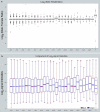Sex-dimorphic gene expression and ineffective dosage compensation of Z-linked genes in gastrulating chicken embryos
- PMID: 20055996
- PMCID: PMC2821371
- DOI: 10.1186/1471-2164-11-13
Sex-dimorphic gene expression and ineffective dosage compensation of Z-linked genes in gastrulating chicken embryos
Abstract
Background: Considerable progress has been made in our understanding of sex determination and dosage compensation mechanisms in model organisms such as C. elegans, Drosophila and M. musculus. Strikingly, the mechanism involved in sex determination and dosage compensation are very different among these three model organisms. Birds present yet another situation where the heterogametic sex is the female. Sex determination is still poorly understood in birds and few key determinants have so far been identified. In contrast to most other species, dosage compensation of bird sex chromosomal genes appears rather ineffective.
Results: By comparing microarrays from microdissected primitive streak from single chicken embryos, we identified a large number of genes differentially expressed between male and female embryos at a very early stage (Hamburger and Hamilton stage 4), long before any sexual differentiation occurs. Most of these genes are located on the Z chromosome, which indicates that dosage compensation is ineffective in early chicken embryos. Gene ontology analyses, using an enhanced annotation tool for Affymetrix probesets of the chicken genome developed in our laboratory (called Manteia), show that among these male-biased genes found on the Z chromosome, more than 20 genes play a role in sex differentiation.
Conclusions: These results corroborate previous studies demonstrating the rather inefficient dosage compensation for Z chromosome in birds and show that this sexual dimorphism in gene regulation is observed long before the onset of sexual differentiation. These data also suggest a potential role of non-compensated Z-linked genes in somatic sex differentiation in birds.
Figures





Similar articles
-
Faced with inequality: chicken do not have a general dosage compensation of sex-linked genes.BMC Biol. 2007 Sep 20;5:40. doi: 10.1186/1741-7007-5-40. BMC Biol. 2007. PMID: 17883843 Free PMC article.
-
Transcriptome sequencing reveals the character of incomplete dosage compensation across multiple tissues in flycatchers.Genome Biol Evol. 2013;5(8):1555-66. doi: 10.1093/gbe/evt114. Genome Biol Evol. 2013. PMID: 23925789 Free PMC article.
-
Dosage compensation is less effective in birds than in mammals.J Biol. 2007;6(1):2. doi: 10.1186/jbiol53. J Biol. 2007. PMID: 17352797 Free PMC article.
-
Sex determination and gonadal sex differentiation in the chicken model.Int J Dev Biol. 2018;62(1-2-3):153-166. doi: 10.1387/ijdb.170319cs. Int J Dev Biol. 2018. PMID: 29616724 Review.
-
Sex chromosome dosage compensation: definitely not for everyone.Trends Genet. 2013 Dec;29(12):677-83. doi: 10.1016/j.tig.2013.07.005. Epub 2013 Aug 14. Trends Genet. 2013. PMID: 23953923 Review.
Cited by
-
Independent evolution of transcriptional inactivation on sex chromosomes in birds and mammals.PLoS Genet. 2013;9(7):e1003635. doi: 10.1371/journal.pgen.1003635. Epub 2013 Jul 18. PLoS Genet. 2013. PMID: 23874231 Free PMC article.
-
RNA sequencing reveals sexually dimorphic gene expression before gonadal differentiation in chicken and allows comprehensive annotation of the W-chromosome.Genome Biol. 2013 Mar 25;14(3):R26. doi: 10.1186/gb-2013-14-3-r26. Genome Biol. 2013. PMID: 23531366 Free PMC article.
-
Avian sex, sex chromosomes, and dosage compensation in the age of genomics.Chromosome Res. 2014 Apr;22(1):45-57. doi: 10.1007/s10577-014-9409-9. Chromosome Res. 2014. PMID: 24599719 Review.
-
Cell-autonomous sex determination outside of the gonad.Dev Dyn. 2013 Apr;242(4):371-9. doi: 10.1002/dvdy.23936. Epub 2013 Mar 1. Dev Dyn. 2013. PMID: 23361913 Free PMC article. Review.
-
NEUROG2 drives cell cycle exit of neuronal precursors by specifically repressing a subset of cyclins acting at the G1 and S phases of the cell cycle.Mol Cell Biol. 2012 Jul;32(13):2596-607. doi: 10.1128/MCB.06745-11. Epub 2012 Apr 30. Mol Cell Biol. 2012. PMID: 22547683 Free PMC article.
References
Publication types
MeSH terms
Grants and funding
LinkOut - more resources
Full Text Sources

